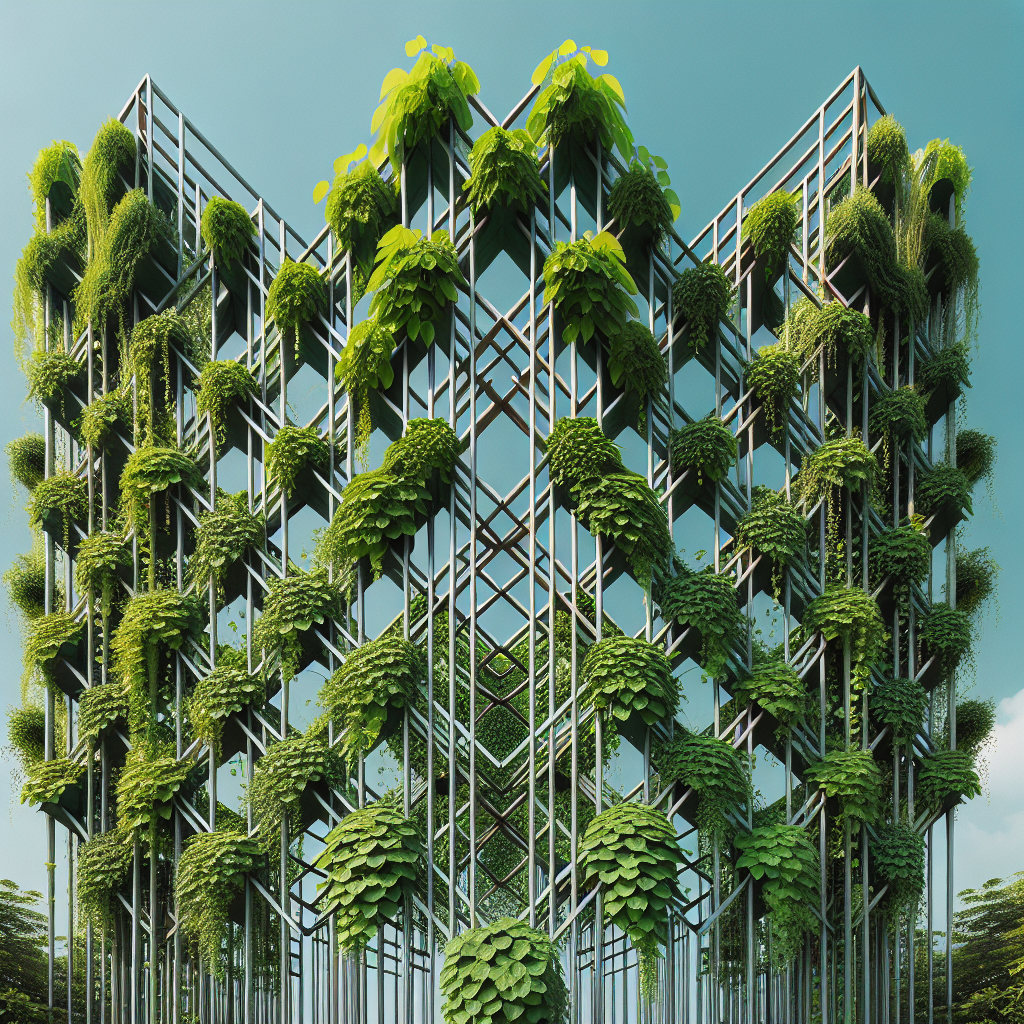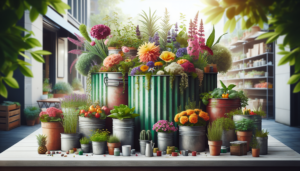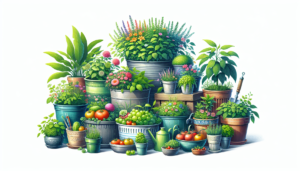
Container gardens are a fantastic way to bring the beauty of nature into small spaces, but finding enough room for all your favorite plants can be a challenge. If you’re tired of limited space forcing you to choose between your favorite flowers, fruits, and herbs, then it’s time to embrace the art of maximizing vertical space in your container garden. By utilizing smart planting strategies and incorporating vertical structures like trellises and hanging baskets, you can create a lush and thriving garden that reaches new heights, literally. Say goodbye to overcrowded pots and hello to a garden that defies gravity.
Choosing the Right Containers
When it comes to maximizing vertical space in your container garden, the choice of container height is an important factor to consider. Opting for tall and narrow containers can provide you with more planting space in a limited area. These types of containers allow you to grow plants with deeper root systems and provide better drainage. By choosing containers that take up less horizontal space, you can effectively utilize vertical space and create a vibrant and lush garden.
One option to consider for maximizing vertical space is the use of hanging baskets. Hanging baskets allow you to grow plants from above, freeing up valuable floor or ground space. They can easily be suspended from hooks or brackets attached to a wall or overhead structure. This not only adds visual interest to your garden but also enables you to grow a variety of flowers, herbs, or trailing plants in a compact manner.
Another practical solution for utilizing vertical space is stacking containers. By stacking containers one on top of the other, you can create layers of plants and maximize your planting area. This is particularly useful for small balconies or patios where floor space is limited. Vertical stacking not only provides an attractive display but also allows you to grow a variety of plants in a small footprint.
Vertical Plant Selection
Selecting the right types of plants is crucial for maximizing vertical space in your container garden. Choosing plants that naturally grow tall will enable you to take advantage of the vertical dimension. Look for plant varieties that are known for their upright growth habit and can reach significant heights. Examples include sunflowers, hollyhocks, and tall grasses.
Using vining plants is another excellent way to make use of vertical space. These plants have the ability to climb and trail, allowing them to cover walls, trellises, or stakes. Consider growing cucumbers, beans, peas, or ivy in your container garden to add an element of verticality and lushness. Vining plants not only provide aesthetic appeal but can also provide shade or act as a privacy screen.
Additionally, selecting plants with a narrow growth habit is beneficial when trying to maximize vertical space. Look for plants that have a columnar or upright shape instead of those that spread out horizontally. This allows you to plant more specimens in a limited area and create a visually appealing vertical garden. Boxwood, yucca, and bamboo are excellent choices for narrow-growing plants.
Utilizing Trellises and Stakes
Incorporating trellises and stakes into your container garden can provide support for climbing plants and create a visually striking vertical display. Installing trellises against a wall or free-standing in a container allows vines and climbing plants to grow upwards, making efficient use of vertical space. This not only adds height to your garden but also provides a beautiful backdrop for other plantings.
When using stakes, you can provide support for taller plants that may need additional reinforcement. Stakes can be inserted into the container soil, providing stability for plants that tend to lean or become top-heavy. This ensures that your plants grow upright and reduce the risk of damage or collapse. Sturdy stakes made of metal or wood are recommended for better stability and durability.
Utilizing netting is another method for promoting vertical growth in your container garden. By attaching netting to trellises or stakes, you create a support structure for climbers and vining plants. This allows them to latch onto the netting and grow vertically, creating a lush and dense display. Netting provides a cost-effective and adaptable solution for maximizing vertical space in your garden.
Hanging Planters and Wall-Mounted Systems
Hanging planters offer a practical and visually appealing solution for maximizing vertical space. By suspending planters from brackets or hooks, you can create a stunning display that adds visual interest to any vertical surface. Hanging planters can be utilized on walls, fences, or even from pergolas or arbors. This allows you to take advantage of otherwise unused space and create an eye-catching garden.
Wall-mounted systems provide another option for vertical gardening. By installing wall-mounted planters, you can grow a wide variety of plants in a compact manner. These systems are designed to be efficient in terms of space usage, allowing you to maximize the available vertical area. Wall-mounted planters come in various sizes and designs, catering to different types of plants and personal preferences.
Similarly, utilizing pocket planters can be an effective way to maximize vertical space. Pocket planters are made up of several individual planting pockets, which can be mounted on a wall or fence. This allows you to grow plants in a vertical arrangement, making efficient use of limited space. Pocket planters are ideal for growing herbs, succulents, or trailing plants, creating a lush and vibrant vertical garden.
Utilizing Espalier Techniques
Espalier techniques involve training plants to grow along a trellis or wire frame, creating a horizontal growth pattern. This technique is particularly useful for maximizing vertical space in a container garden. By training plants to grow in a controlled and horizontal manner, you can create a visually appealing and space-saving display.
To utilize espalier techniques, choose plants that are suitable for this type of growth habit. Fruit trees, such as apple or pear trees, are commonly trained using espalier techniques. By pruning and tying branches to a trellis or wire frame, you can guide the growth of the plant and create a structured and horizontal display. The espalier technique not only maximizes vertical space but also allows for easy maintenance and harvesting.
Pruning is another aspect of espalier techniques that helps to encourage horizontal growth. By selectively removing branches or stems, you can shape the plant and promote outward growth. This helps to create a dense and lush foliage cover on the trellis or wire frame. Regular pruning is necessary to maintain the desired shape and ensure the health and longevity of the plants.
Stacking and Tiered Designs
Using tiered plant stands is an effective way to maximize vertical space in your container garden. Tiered stands typically consist of multiple levels or shelves where you can place your containers. This allows you to create a cascading effect and display a variety of plants in a compact manner. Tiered stands are available in various sizes and materials, providing flexibility in terms of design and plant selection.
Stacking containers vertically is another innovative approach to maximize your planting area. By stacking containers on top of one another, you can create a vertical garden that saves space and looks visually appealing. This method is particularly useful for small balconies, rooftop gardens, or narrow walkways. Make sure to choose lightweight containers and secure them properly to prevent accidents or damage.
Utilizing vertical shelving units is a practical solution for maximizing vertical space in your garden. With the help of these freestanding structures, you can create a multi-tiered display of plants. Vertical shelving units often consist of multiple shelves where you can place your containers. This not only allows you to grow more plants but also adds a vertical focal point to your garden.
Utilizing Hanging Structures
Hanging baskets or containers are a versatile and space-saving solution for vertical gardening. Instead of taking up valuable floor or ground space, you can suspend baskets or containers from a pergola or arbor. This creates an enchanting display of plants that hang down, adding depth and verticality to your garden. Hanging structures not only offer an efficient use of space but also create a beautiful and lush environment.
Using hanging structures like a hanging bag garden is another way to maximize vertical space. Hanging bag gardens consist of durable bags with multiple planting pockets. These bags can be hung from a wall, fence, or any vertical surface. The planting pockets provide ample space for growing a variety of plants, making efficient use of limited space. Hanging bag gardens are particularly well-suited for herbs, flowers, or trailing plants.
Utilizing vertical hanging pocket systems is yet another option for maximizing vertical space. These systems are made up of multiple individual pockets that can be attached to a wall or fence. Vertical hanging pocket systems allow you to grow plants in a space-saving manner, enhancing the vertical aesthetic of your container garden. You can easily mix and match different plants and create a vibrant and diverse display.
Implementing Vertical Accessories
To further maximize vertical space, consider installing vertical planter pockets on your walls or fences. These pockets allow you to grow plants in a vertical arrangement, adding visual interest and making efficient use of limited space. Vertical planter pockets are available in various sizes and designs, allowing you to create a customized vertical garden. They are particularly useful for growing herbs, flowers, or small vegetables.
Another option is to attach vertical gardening racks to your walls or fences. Vertical gardening racks provide a sturdy structure for holding multiple pots or containers. By utilizing these racks, you can create a vertical display that showcases a variety of plants. This method maximizes space usage and allows you to have a diverse container garden in a limited area.
Utilizing vertical planters with multiple pockets is a practical and efficient way to maximize vertical space. These planters consist of multiple individual pockets, which can be mounted on a wall or fence. By utilizing vertical planters, you can grow a variety of plants in a small area, adding height and visual impact to your garden. Vertical planters with multiple pockets are available in different materials and sizes, catering to various plant types and personal preferences.
Incorporating Garden Structures
Incorporating garden structures into your container garden can greatly maximize vertical space and enhance the visual appeal. Building a vertical pallet garden is a creative and eco-friendly way to provide a structure for your plants. By attaching planters or pots to a wooden pallet, you can create a stunning vertical display. Vertical pallet gardens are an excellent solution for small outdoor spaces, as they offer versatility and allow you to grow a variety of plants.
Creating a ladder trellis is another unique approach to maximizing vertical space. A ladder trellis can be made using a wooden ladder or constructing a trellis in the shape of a ladder. By leaning the ladder trellis against a wall or fence, you provide support for climbing plants and add height to your garden. Ladder trellises offer a visually pleasing and functional solution for vertical gardening.
A living wall is an impressive way to maximize vertical space and transform your container garden into a work of art. Living walls are created by attaching a series of planters or containers to a vertical structure, such as a wall or fence. By carefully selecting a variety of plants, you can create a vibrant and dynamic display that serves as a focal point in your garden. Living walls are ideal for both indoor and outdoor spaces, bringing nature to new heights.
Using Creative Planting Techniques
In addition to utilizing various structures and techniques, implementing creative planting techniques can further enhance the verticality of your container garden. Planting in a spiral pattern is an innovative and visually appealing technique that maximizes planting space. By starting with a central plant and spiraling outward, you can fit more plants into a limited area. This creates a stunning display that adds depth and interest to your garden.
Implementing square foot gardening is another technique that maximizes space usage. By dividing your containers into small grids or squares, you can efficiently organize and maximize the number of plants in your garden. This technique allows for easy maintenance and ensures that each plant receives adequate space and nutrients. Square foot gardening is a popular method for creating productive and thriving container gardens.
Utilizing cascading or layering planting styles adds a sense of depth and lushness to your vertical garden. This technique involves arranging plants with varying heights and growth habits to create a layered effect. By strategically placing taller plants in the back and cascading or trailing plants in the front, you can create a visually stunning and multi-dimensional display. Cascading or layering planting styles are commonly used in hanging baskets or wall-mounted systems to maximize the vertical space.
By considering the height of the containers, selecting suitable plants, utilizing trellises and stakes, incorporating hanging planters and wall-mounted systems, implementing espalier techniques, using stacking and tiered designs, utilizing hanging structures, implementing vertical accessories, incorporating garden structures, and using creative planting techniques, you can successfully maximize vertical space in your container garden. With these techniques and strategies in mind, you can create a lush and vibrant garden that makes the most of limited space and provides a delightful oasis of greenery.







